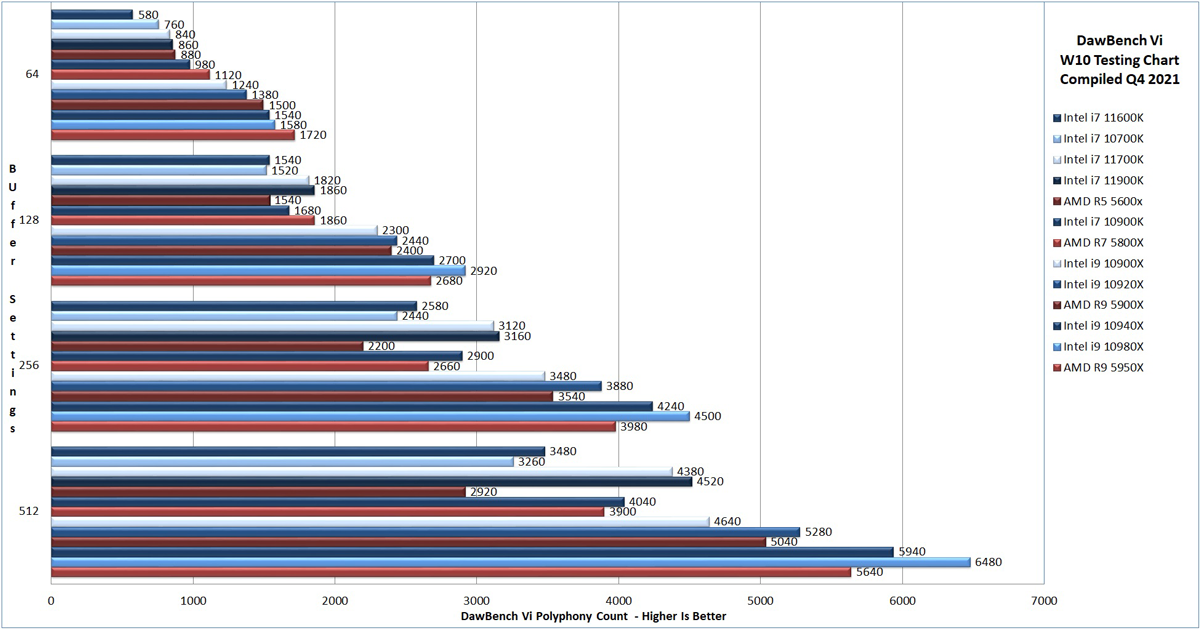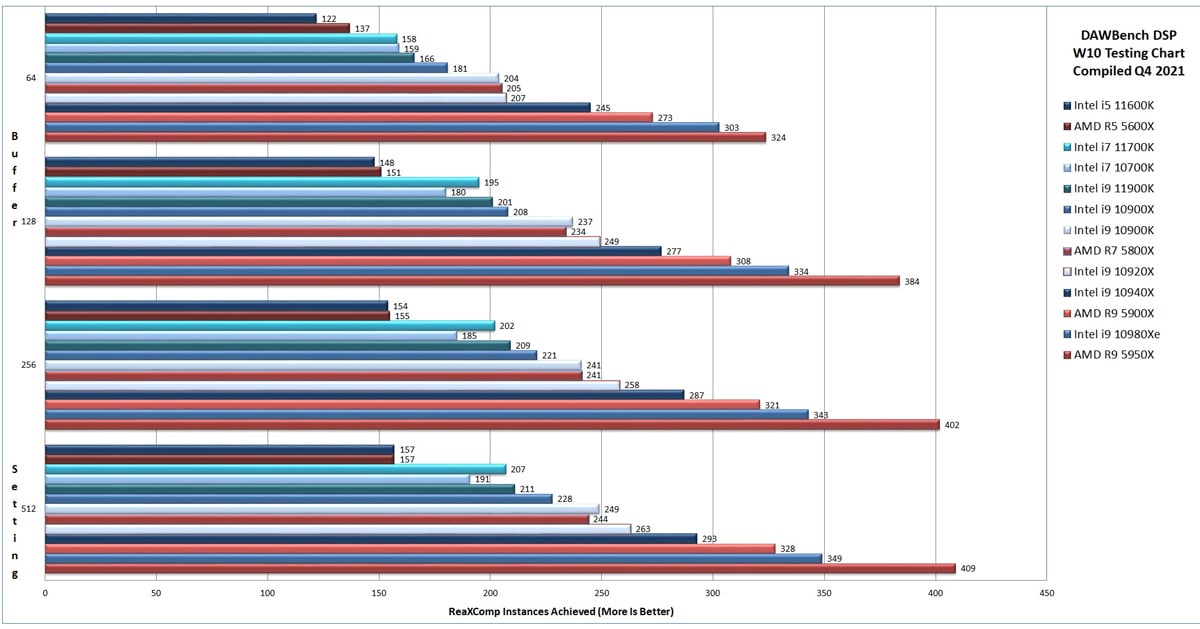DAWBENCH CPU performance results
Welcome to our final round up on Windows 10, where we're taking a look at CPU performance using the newly refreshed and relaunched DAWBench testing suite.
Back at the introduction of the AMD 5000 series we realised that the old test versions would need to be reworked in order to support the results being produced by both current and future generations. Vin over at DAWBench has been busy making a number of updates to both the VI and DSP tests, with this round of testing being our first on the new builds.
The key change is that the instances within the tests they have been increased to allow new upper limits to be reached, in the VI test this also involved setting a new baseline up by having the first 160 instances of Kontakt load in on launch whilst leaving the rest initially unloaded from memory. With the extended tests we found a number of the smaller chips getting instantly overloaded, so this gives us a suitable starting point to work from, no matter which size chip we're testing.
Also supporting this are a number of small engine changes within the preferences setup. The threading behaviour has been switched from the old default of 4 to 3 which halved the reserved CPU resource load, allowing for a wider spread of systems to be tested. Since the initial testing phase this change has now been implemented into the current versions of Reaper as the default for all users.
During testing we've also found that allowing antipative FX processing to be assigned across all tracks, rather than its default setting which gave us better performance handling over the last 5% or 10% of the CPU's upper limit. This proved most evident on the highest core count CPU's in testing, with the change helping to ensure that the processing is more evenly spread which allowed us to get the best from all the setups.
Testing is conducted with the RAM slots fully populated in each instance and the memory in use has also been revised to reflect our current ranges. Whilst the DSP testing remains fairly constant, a small speed bump on the memory above spec for both chipsets has been proving effective for system optimization. In Intel testing we're seeing that stepping it up a speed grade (with the 10 series at 3200MHz and 11 series at 3600MHz) can offer gains of around 8% - 10%, although above this quickly tails off with smaller incremental gains as you move to larger kits. With the AMD we remain at 3600MHz as our choice as it continues to perform well when fully populated, whilst still offering gains over its official 3200MHz rating.
In both instances raising above these points with a fully populated board can start to prove tricky and these are currently our sweet spots for getting the best performance with a rock solid system.
A full configuration guide will be made available with the new test suite itself available from the DAWBench site.
Both the Intel 11 series and AMD 5000 series appear for the first time here with some big changes under the hood.
Intel's Rocketlake line-up is a stepping stone to their new 10nm process and we see a range here that takes that new design, but backports it to 14nm whilst the new manufacturing process is refined. The new process promises improved per core performance, but without the full process shrink the top solution is limited to an 8 core model.
For AMD it was a rework of their memory system, with testing of the chips up against earlier generations making it clear that on matching setups we were seeing a 15ns-20ns reduction in comparable RAM & Mainboard arrangements. With the earlier AMD 3000 series it was evident at points that the higher memory latency could affect its performance levels, more noticeably at lower ASIO buffer settings. The reduction in memory latency in this round of testing does look to have largely closed the hole, with even the lowest buffer settings generally getting close to 100% from the chip itself. The big ask is how has this helped performance in general and specifically how does it help it stack up against Intel’s more mature memory system design.


On raw performance alone the 5000 series proves strong in the DSP testing, with Intel’s upper most model finding itself sandwiched between AMD's 5950X and 5900X models results wise. The rest of the Intel X299 range follows along with the AMD 5800X before we get to a small surprise in the shape of the Intel 10900K.
Beating out both the X299 based 10900X, along with its successor the 11900K. The following generations reduced core count, means that even with a notable per core clock increase in speed, it hasn't been quite enough to keep up with the 10900K. This creates a differentiator between the two models as it means that the newer 11900K's increase in single core performance perhaps helps to make it more suited for live recording scenarios, where maximising your single core performance can help to ensure smoother handling when working with super low latency’s whilst recording performances. For those working in the box or focused on production with higher track counts however, being able to spread the load over the extra cores can often prove to be more beneficial.
Looking over the Kontakt VI test and the results become more mixed as we see both the CPU and memory system coming into play. The fine tuning of AMD's memory whilst strengthening its lower latency performance, Intel’s quad channel design still helps it to stay ahead at higher latency settings more commonly used when working in the box. We see this repeated throughout the results with Intel tending to skew better as the ASIO buffer is raised.
The 10900X in this instance likely thanks to the memory arrangement stays ahead of the newer 10900K, which itself hangs on with the lead over the newer models at the very tightest setting. As the buffer is relaxed the 11 series chips make better gains however, with the increase in RAM performance likely helping it here along with the newer microarchitecture design.
Intel’s Z590 chipset brought PCIe4.0 to the range for the first time with a GPU slot & M.2. slot benefiting from the change, much like the AMD B550 chipset arrangement. This leaves AMD's X570 platform uniquely placed with a full complement of PCIe4.0 slots and M.2 ports, at least until Intel’s forthcoming X699 HEDT platform arrives in 2022.
Elsewhere looking into the future, the next arrival is looking likely to be Intel’s Alder Lake platform. Taking the current 11th generation CPU design and making the shrink down to 10nm. With an already proven series of single core gains, a reduction in size should allow more cores to be introduced back in. The early details for the 12900K model has it pitched with a big/little core design where the full speed cores are hyper-threaded and lower clocked cores are single threaded, this gives us a resulting 24 thread design over an 8 + 8 big/little core arrangement. Apple has already moved on to a similar design choice with its newest hardware releases, with early adoption proving sometimes rocky things have reportedly been improving as code is fully ported and optimized to take
advantage of the new platform.
Similarly, the change in PC hardware will need OS level support and Windows 11 will shortly be arriving with us, offering that support for the next generation of hardware. Load balancing will be key to getting the very best from future hardware and Windows 11 will introduce the new Thread Director system with this in mind. Taking advantage of real-time monitoring at chip level, the system will aim to prioritise workloads onto the most suitable cores for each application. Applied successfully this could result in our DAW applications being given the run of the big cores and windows background services or any other applications being placed out of the way on the little cores. Done well and this could help to offer smoother audio application handling through the fencing off the system
based background processing.
The new Thread Director will be limited to Windows 11, although the OS will also still offer classic threading support for older chips too. This change of course means that we shall return next time it will be with our first round of Windows 11 based testing.